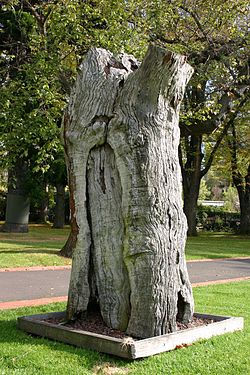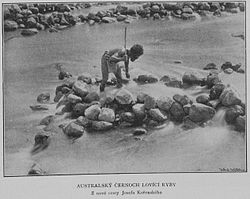Protection Boards and Protection Acts and their amendments formed the legislative base for ever-increasing control over many aspects of Indigenous lives. Legislation and policy controlled nearly every aspect of Indigenous lives: where you could live, what jobs you could have, who you could marry, whether you could be raised by your parents, which family members you could interact with, whether you were Aboriginal or not.
Prior to 1860 there was no official legislation dealing with Aboriginal peoples. In 1860 a Board of Protection was established in Victoria. By 1862 it superintended seven reserves and twenty-three small camping places. The Governor of Victoria could order the removal of any child to a reformatory or industrial school. The Protection Board could remove children from station families to be housed in dormitories. By 1869 about 50% of the Victorian Aboriginal population was living on missions or reserves.
After this time
Aborigines Protection Acts were introduced colony by colony. The earliest, again, was introduced in 1869 in Victoria, as an
Act to Provide for the Protection and Management of the Aboriginal Natives of Victoria, which was later transformed into the
Aborigines Protection Law Amendment Act 1886. This was “the first statute to legislate for the differential treatment of ‘full-blood’ and ‘half-caste’” reflecting the type of thinking about ‘race’ and skin colour that we read about above (Haebich, 2000, p.165). The Queensland
Aboriginals Protection and Restriction of the Sale of Opium Act 1897 set up a “system of segregation, surveillance and control” that was to provide the model for later laws that were passed in Western Australia, South Australia and the Northern Territory in the early years of the twentieth century (Haebich, 2000, p. 171).
In NSW, a Protector of Aborigines was appointed in 1881 and a Aboriginal Protection Board was established in 1883. The NSW Aborigines Protection Act was introduced in 1909 and was not abolished until 1969. Indigenous people in New South Wales had their lives controlled by the Aborigines Protection Board and with the passing of this law Aboriginal people were forced to “merge with the wider community. This would lead, the Board hoped, to the eventual ‘withering away’ of the communities” (Haebich, 2000, p. 182).
In Queensland, J. W. Bleakley, Chief Protector and Director of Native Affairs from 1913 to 1942, exercised a major influence over Queensland policy and the practices of officials and the missions. He believed firmly in the segregation of Indigenous people from non-Indigenous people. As he outline in 1919:
| “
|
It is only by complete separation of the two races that we can save him (‘the Aborigine’) from hopeless contamination and eventual extinction, as well as safeguard the purity of our own blood (Chief Protector Report 1919).
|
”
|
While policies in Queensland continued to emphasise segregation, other states shifted towards policies of cultural ‘assimilation’ and ‘biological absorption’, both of which were aimed at making the ‘Aboriginal problem’, and Aboriginal people, disappear.
Throughout the 19th and 20th centuries, governments put in place extensive controls over the employment, working conditions and wages of Indigenous workers. These controls permitted, both explicitly and implicitly, the non-payment of wages to some Indigenous workers, as well as the underpayment of wages, and the diversion of wages into trust and savings accounts. Many Indigenous people never received the wages that were supposedly held in ‘trust’ for them. Often these funds were misappropriated by governments or sometimes taken by corrupt officials (Commonwealth of Australia, 2006; Kidd, 2007).
Look at the NSW Aborigines Protection Act (1909)
- What powers does it give the government?
- What rights does it take from Indigenous people?
Below are links to some of the key Protection Acts in other colonies/states.
All of the original Protection legislation can be found on the Australian Institute of Aboriginal and Torres Strait Islander Studies (AIATSIS) website:
Key Protection Acts:
Victoria

Scarred tree in Fitzroy Gardens, the scar is left after a canoe has been cut out of the trunk
The
Aborigines Protection Act 1869 constituted a
“Board for the Protection of Aborigines”. The Board was given no specific power until the
Aborigines Protection Act 1886. The Board gained regulatory powers in respect of ‘half-castes’ and the power to issue rations, clothing and blankets.
To provide for the Protection and Management of the Aboriginal Natives of Victoria.
Victorian Historical Acts The Aborigines Protection Act 1886
Queensland
Aboriginal Protection and Restriction of Opium Act became law in 1897. Section 4 of the Act reads as follows:
Every person who is:
Torres Strait Islanders
When the Aborigines Protection Act was introduced in Queensland in 1897, it was argued that the Islanders should be exempt from its provisions, but in 1907 the control of the Islanders passed to the Queensland Chief Protector.
Northern Territory
Prior to 1911 the Northern Territory was administered by South Australia. The first legislation was the Northern Territory Aborigines Act 1910" passed by the South Australian parliament. The Northern Territory Aboriginal Department was set up with a duty to:
| “
|
“exercise a general supervision and care over all matters affecting the welfare of the Aboriginals, and to protect them against injustice, imposition and fraud” s6(6).
|
”
|
New South Wales
A Protector was appointed in NSW (George Thornton, former Lord Mayor of Sydney) in 1881 and a Board for the Protection of Aborigines was established in 1883. The Aborigines Protection Act was introduced in 1909. Under the 1909 Act the police were expected to conduct a number of functions; they were the representatives of the Protector.
Western Australia
The Protection Act 1886 established the Aborigines Protection Board. The Aborigines Protection Act 1905 was the main protection legislation. The Protection Board began setting up schools for the training of Aboriginal children.

|


